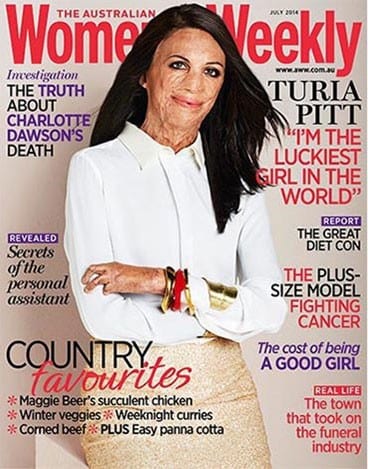The Australian Women’s Weekly is Australia’s most-read women’s publication, with a circulation of 451,000. It remains popular as many magazines falter. Going on 81 years old, its readership skews older (24 to 54 according to the rates card), and is more inclined to appreciate so-called “real people” on the cover. Previous Women’s Weekly cover girls include former prime minister Julia Gillard, former Queensland premier Anna Bligh and publishing legend Ita Buttrose. So it’s not unusual for the magazine to feature someone not known for their modelling on the front. But July’s cover is still, for the magazine industry, shocking.
It’s of burn survivor Turia Pitt, who in 2011 suffered burns to 64% of her body after being caught in a freak firestorm while competing in a marathon. She wasn’t expected to survive, but has recovered. She’s since raised $180,000 for charities that help burns victims in developing countries.
On the front of the Women’s Weekly, she’s pictured simply, wearing a white shirt and gold skirt, her disfigured hand clearly visible in the centre of the frame.
Helen McCabe, editor-in-chief of Women’s Weekly, only gets 12 covers a year. It’s a big deal — no other single element of the magazine is more responsible for whether an issue flops or sells. “I can’t muck around with the cover,” she tells Crikey from her office in Sydney’s Bauer HQ. “It’s fundamental to the business model.”
Few celebrities are ever profiled in women’s magazines without airbrushing — indeed, many insist on it. Pitt, who used to be a model, is a stark departure from industry practice. The cover has been hailed from near and far, with dozens of industry observers commenting on it. Lisa Wilkinson, former editor of Cleo, describes it as “stunning”. Mamamia, founded by former editor-in-chief of Cleo, Dolly and Cosmo Mia Freedman, has called it the most important photograph to appear on the cover of an Australian magazine.
But it’s a risk, says Marina Go, a former editor of Dolly and editor-in-chief of ELLE (and now Crikey’s CEO). “As soon as I saw the cover, I thought it was fantastically brave,” she says.
The photograph featured on the front was not originally intended for the cover, but taken as part of the photo shoot of the panel of judges for the Australian Women’s Weekly’s Women of the Future scholarship competition.
McCabe has wanted Pitt’s story for years. “I was very moved by her,” she says. “I remember thinking, in 2011, this is the one story I want this year.” She missed out — Pitt was featured on Channel Nine’s 60 minutes instead. But McCabe kept an eye out for opportunities to use her, and this year, invited her on the judging panel for the scholarship, alongside women like Jennifer Hawkins and Penny Wong (Channel Nine gave Pitt permission to participate).
McCabe admits she was “totally fixated” on Pitt, who she describes as an inspirational, beautiful young woman. “This thesis that beauty isn’t so much about what you look like than about who you are gets bandied about a lot in women’s magazines … She was the embodiment of that. In this shoot, she was standing next to Jennifer Hawkins — which would be intimidating for most women — but it clearly wasn’t confronting at all for her.”
Soon after the photo shoot, Pitt reached a legal settlement with the organisers of the race at which she was burned. It was then that AWW’s staff began to muse of putting her on the cover. To McCabe’s surprise, the image worked. “A lot of images, for whatever reason, don’t work on covers, but she did,” she said. And Pitt really wanted it. McCabe says working with her was like working with any other celebrity. “She wanted to see the pictures, make sure she looked right. She wanted to make sure it worked.”
Everything being set, the cover was released earlier this week. The issue went on sale yesterday. And McCabe’s inbox was flooded.
Many highlighted the commercial bravery of McCabe’s decision, which, she admits, has made her more nervous about sales than she was before. But the cover, she insists, makes perfect sense. “It ticks every box. It’s a story worthy of the cover. And we know stories of triumph over adversity are stories women respond to. And she has an incredible story to tell. She’s Australian. She’s admired. And she evokes emotion when you look at the cover. That’s very rare. I’ve seen it in people when they pick it up — they get emotional about it.”
The readers will decide. McCabe says if they like it, they should buy it. If they don’t, it could be a while before anyone tries this again.



